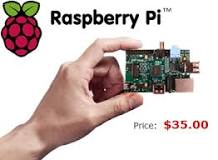What and Why a Raspberry Pi? |
 |
The Raspberry Pi® is a single-board, low-cost, high-performance computer first developed at Cambridge University and now supported by the Raspberry Pi Foundation. Originally developed as an affordable training tool, it has become a mainstay in the world of electronic experimenters and tinkerers. Conceived as using smart-phone technology and building a simple yet powerful and inexpensive full-blown computer, it has evolved into a family of computer systems, with more than 40 million units in use world-wide.
It is becoming and will be the most omniscient stand-alone computer anywhere. Not only has it helped bring the joy of electronics and computer programming to people around the world, but it has also become a staple of the embedded community. The widely used Pi's latest iteration is the Raspberry Pi 4 Model B, and the Pi Foundation continues to improve on an already excellent product line. The basic features of the WiFi enabled Pi ZeroW make it ideal for use in a marine environment.
Almost any hand-held device can access SailPro via WiFi and hosted on a RPi Mod B or ZeroW (Pi0W). It is small, light weight, cheap, and draws minimal voltage via a USB connector. Using Low power consumption, it could run more than a year on a typical marine battery (but does not need continuous power). Its low price makes it usable to everyone everywhere, even on a 'run-about' boat with an outboard engine. Being small and lightweight allows it to be housed in a water-tight case with only a single USB power connector. So why not use SailPro directly on an RPi or a smart-phone?
The answer involves four concepts: visibility, redundancy, transport-ability, and the computer paradigm. A scoring program loaded on one smart-phone stays with that phone and cannot be easily given to another race committee crew or moved to an alternate boat. Also when data resides on one phone, it cannot be easily view-able from another. With SailPro a P.R.O. can review results on his phone while the scorer continues to enter finish data on a tablet. Some clubs may use alternate RC boats for different regattas, and the Pi is easily moved from one RC boat to another. This flexability is partly enabled because SailPro on an RPi is not dependent on having special connecting hardware for internet access. Ultimately using SailPro, the Race Committee RPi becomes the central repository for a club's past race results.
SailPro uses WiFi access two ways: as a server and as a client. It is a server for its primary user functionality, namely data-entry and result-review. As a client, SailPro will connect to an internet access-point when available, and transmit data to a cloud based archive. It can also transmit results to an internet accessible web-site. This process only occurs when there is no local user activity and new or modified results need to be posted. SailPro will then scan for a club-house based access-point and connect to an external network server as a client.
The Primary Paradigm of Computers
Since the very first computer, all commuter programs have faced a dichotomy of efficiency: the trade-off between storage versus speed. Should a program be written to execute fast regardless of memory and storage requirements, or visa-versa? In contemporary systems this conflict makes processes compete against memory, or, in other words, graphics processing versus data base management. SailPro uses the client-server model to split these functions: the cellphone based browser does Graphics, and the RPi server handles data storage. This divide makes the most effective use of both processors.
Loading and Using SailPro
Sailpro is available as a Debian (...deb) package and can be easily installed onto a Raspberry Pi using dpkg. Doing so will require the RPi to have a keyboard and monitor connected, and the user to have some knowledge of Raspian (Raspberry Pi OS). Before SailPro installation, there are several system options that can be initialized within Raspian if desired, such as a static IP address, and club-house access-point keys, etc.
After installation of SailPro, the RPi becomes a 'head-less' server, meaning it can then be powered-up and/or booted without any user interaction. Thus it no longer needs a keyboard or monitor, and can then be moved into a water-resistant case. Thereafter every time the RPi is powered-on and/or booted, SailPro will be available via WiFi.
Connecting to SailPro
After booting a SailPro enabled Raspberry RPi it becomes an available WiFi network as viewed from a smart-phone. On a tablet (or cellphone or laptop computer), access the 'Scan WiFi' utility, and select the 'Raspberry Pi.' SailPro will set the Pi0W's password-key to 'sunnybeach' (no quote marks), but this key may have been (and can be) reset using a Raspian utility function.
Next open a browser on the tablet, and go the the SailPro address of:
http://score.sailpro
The SailPro Regatta selection menu will be displayed. One of five demonstration regattas can be chosen and manipulated. The demo regattas illustrate some of SailPro's diverse features such as multiple scoring mechanisms, variety of competitors, and numbers of races/classes/starts. Most demos have some races already scored, and one has no finishes. These demo regattas provide a user many facilities to exercise SailPro.
Like what you see?
To receive a free copy of SailPro, send a request via email-address to: info@sailpro.org